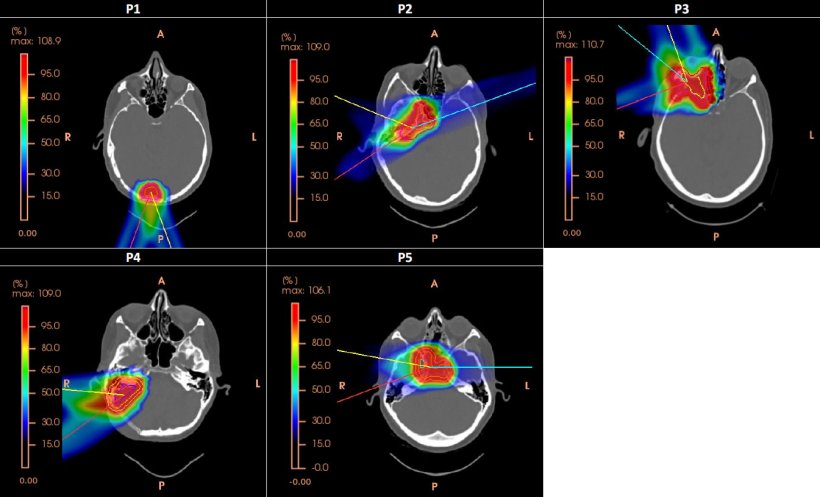© Paul Scherrer Institute PSI/Mahir Dzambegovic
News • Individualized therapy planning
Tumour irradiation: a little different every day
In the treatment of cancer patients, irradiation can be adapted anew each day to the position of the tumour and conditions in the body.
Researchers at the Paul Scherrer Institute PSI have now, for the first time, integrated such a workflow into everyday clinical practice in proton therapy – an important step in the individualisation of therapy. The study appeared in the scientific journal Physics in Medicine and Biology.
Every day, our body is a little bit different. The intestines are sometimes more full, sometimes less; sometimes there’s more air rumbling in there, sometimes less. Yesterday the nose was clear – today you have to blow your nose often, and the sinuses are full of mucus. Not to mention that many people lose or gain weight over time.
We can ensure that the target volume – that is, the tumour – is hit precisely. Thus, the overall radiation load is reduced, since healthy tissue is less exposed
Francesca Albertini
Most of the differences that can be seen from one day to another are slight and occur on a scale of millimetres. “But for cancer patients who are irradiated with protons, even such small changes can have significant effects on the optimal radiation dose,” says Francesca Albertini, medical physicist at PSI’s Centre for Proton Therapy. More or less mucus, air, musculature, or fat – all that should be taken into account in calculating the treatment plan. In a worldwide first, PSI researchers have now succeeded for the first time in integrating this approach into daily clinical practice. This latest pioneering achievement of the Centre for Proton Therapy in Villigen will now further improve an already excellent treatment.
Exactly like photons in conventional radiation therapy, protons kill cancer cells. Protons, however, are particles with mass and charge, and the depth of their penetration into tissue is very precisely determined by physics. On the way through the body, they lose very little of their energy and release most of it into their target, the tumour – where they literally get stuck. To ensure that the tumour is irradiated as completely as possible and that the surrounding tissue is protected, patients are scanned with computed tomography (CT) before the start of proton therapy. A treatment plan is drawn up: The doctor calculates which area of the body will be precisely scanned in three dimensions with the proton beam, as well as how energetic the beam needs to be.
During a course of proton therapy, the tumour is irradiated on five days of the week, usually for two to seven weeks. If the treatment plan is newly adjusted every day to the patient’s current anatomy, the irradiation will be even more precisely targeted.
With the new workflow, a low-dose CT scan is taken before each irradiation. The radiation dose of the proton therapy is then newly calculated on the basis of the current anatomy as well as the positioning of the patient on the treatment couch. For that, Francesca Albertini and her team of PSI researchers developed a software program that adapts the treatment plan to the current situation as recorded in a CT image. After that, the irradiation proceeds immediately according to the new plan. “In principle, such a procedure brings nothing but advantages,” Francesca Albertini says. “We can ensure that the target volume – that is, the tumour – is hit precisely. Thus, the overall radiation load is reduced, since healthy tissue is less exposed.”
A possible disadvantage could be that, overall, more time passes during each application, meaning that patients might need to endure a longer time on the couch. In a worst-case scenario, fewer people could be treated per day, so fewer would benefit from proton therapy. “For us it was therefore of the utmost importance to optimise the speed of the process,” Albertini stresses. And they were successful: In all, irradiation including adaptation of the treatment plan lasted on average only four minutes longer than without the new procedure.

Image source: Albertini F et al., Physics in Medicine and Biology 2024 (CC BY 4.0)
In a first feasibility study, Francesca Albertini and her team of PSI researchers applied the new procedure to the treatment of five patients being irradiated against tumours in bony regions of the body, such as the skull and the base of the skull. In these regions, fewer daily changes are to be expected than, for example, in the abdomen, where the filling of the intestines and bladder has a major influence. In a next step, the researchers will now also establish their workflow for tumour types that occur in such regions of the body.
An additional CT scan per day does in fact mean an increase in radiation exposure. “But we assume that the risk of secondary cancers triggered solely through the irradiation is not increased by the new process,” says Damien Weber, head and chief physician of the Centre for Proton Therapy. “On the contrary: The risk is actually reduced.” Since the workflow makes proton therapy more precise overall, this ultimately means a net reduction in radiation exposure. In addition, a particularly low-radiation technique is used for the daily CT scans.
“In a few years, all proton therapy centres in the world will probably implement such daily adaptations,” says Antony John Lomax, group head of Medical Physics and co-author of the study. He suspects that commercial solutions may soon become available, such as software that makes adjustments to the treatment plan. “The fact that we are the first to apply such a workflow to everyday clinical practice is an important step in that direction.”
Source: Paul Scherrer Institute; text: Brigitte Osterath
21.09.2024










